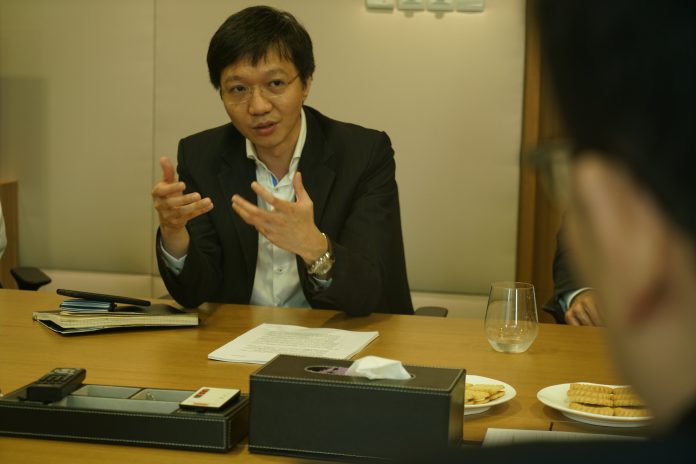Avoiding the ‘hubris’ of FinTech investing and moving to more niche areas was key when launching GTR Ventures, according to co-founder and CIO Kelvin Tan in a research interview with FinTech Global.
Global investments into the FinTech sector reached a total of $39.4bn last year, nearly double the amount raised in 2014, which saw $19.9bn invested around the world, according to data by FinTech Global. In 2017 there were 1,798 transactions, 103 less than in 2014. The number of deals in a year peaked in 2015, with a total of 2,251 being completed, and has slowly been declining since. The industry shows no sign of stopping, with $10bn being invested during the opening quarter of 2018.
GTR Ventures, which has offices in Singapore, London and Hong Kong, launched in September 2017 with a focus on startups operating in the trade finance sector. The firm is looking to support innovation with banks, insurers, corporates and TradeTechs, and aims to increase private capital into trade and SME lending, especially in emerging markets.
Setting up a new venture firm is always met with challenges, such as competing against the existing competition, or trying to prove the firm can make good returns, when there is nothing to back up the claims. However, GTR had an extra difficulty, as it moved into a market that was much more niche and is not as simple to understand.
GTR Ventures co-founder and CIO Kelvin Tan said, “There obviously is a lot of interest in FinTech so we have to ride that, but we wanted to avoid the hubris of FinTech investing and move into something a bit more niche and specialised.”
The issue is that working in a smaller area means that is can take time explaining to investors how it works and what it can offer them. It is the same with any nascent market. Trying to raise money to invest in blockchain technology ten years ago would have been difficult, and now it is much easier. It also gives the firm an added advantage, as they have come from a trade finance background and will be following the market daily, whereas, other firms may not solely focus on the market, making it hard to keep up with the sector and its growing trends.
“It’s not as sexy as the Grab’s, Uber’s and Revolut’s of this world, so to an investor that wants to go deep into understanding FinTech and understanding the revenue drivers, it takes a long time to articulate to fund investors where is the value,” he added.
The firm made its initial five FinTech investments earlier in the year, backing Incomlend, eFundSME, Culum Capital, Trade Finance Market, and Tradeteq. All five companies operated within the trade finance technology space and GTR is looking to support each with their global expansion and product development.
Overall, the whole marketplace lending sector set a new record level for funding in 2017, following a decline in 2016, according to data by FinTech Global. The sector, which includes trade finance, received a total $8.9bn, an increase of $1.4bn. While investment volume was up, the number of transactions had actually fallen by 44.
The firm is hoping to increase the level of private investments into the space and offer a new asset class to investors that may not know about the space. It is a big market which can earn investors a steady rate of returns as this is an ‘evergreen’ sector that will always be needed and won’t disappear. Trade and supply chains are essential to all sectors and regardless of what sector is strong, there will always be a need to finance transportation.
He said, “What we do is bring this space a little bit out there to capital markets to familiarise non-trade finance investors into this space as an exciting new asset class, so investors have more options.”
“An investor with 10 million to deploy, you wouldn’t put all eggs in one basket. You’d put some in venture, stocks and trade finance, we want to offer another channel out there for people who are more adventurous and have a higher risk appetite.”
Asia and Europe have seen their share of funding in the marketplace lending sector rise YoY since 2014. Last year, the three regions received an equal share of the total deals completed, each representing 30.1 per cent of transactions. Asia has seen the biggest increase in market share, having risen from just a 17 per cent portion in 2014.
Future prospects
The reason there is a big opportunity for FinTech companies in the market, is down to banks not serving the entire space. An example Tan gives is, if a company needs supplies but has to also make other payouts, then they will need financing to support this, but a bank may refuse this loan as its too small. FinTechs can serve the underserved market space, where there are one or two per cent yields. As banks are ever moving away from this area, its leaving very attractive opportunities for FinTechs.
He said, “The gap is going to widen as a bank is not geared to service an SME as opposed to a FinTech which is faster, more productive and closer to the customer.”
FinTechs are changing the way things work and Tan sees bank cards potentially becoming used a lot less. Banks will not be the only ones that offer credit, there a shipping lines that provide them to customers with high interest or fees, and the same goes for some online retailers or payment companies. “Tomorrow you may go to the supermarket and when going to pay for the groceries, instead of paying for it, the store gives it for free and charge the card to be paid at the end of the month for 1%.” Offering a trade finance can help businesses to increase their margins per customer.
While there is a section of the market FinTechs are tapping, it’s not going to see the end of banks. Trade is such a big market and FinTechs are chipping away at a colossal monster, and it will be very difficult for them to just replace the established institutions.
Tan said, “This whole notion that FinTechs or lending techs are going to dominate and disrupt the banks is a bit too black and white for me. It’s not one against the other.
“You will also see LendingTechs starting to be regulated. Only time will tell if FinTechs can bear the brunt of a tighter regulatory framework and not buckle under the cost pressure.”
Copyright © 2018 FinTech Global








